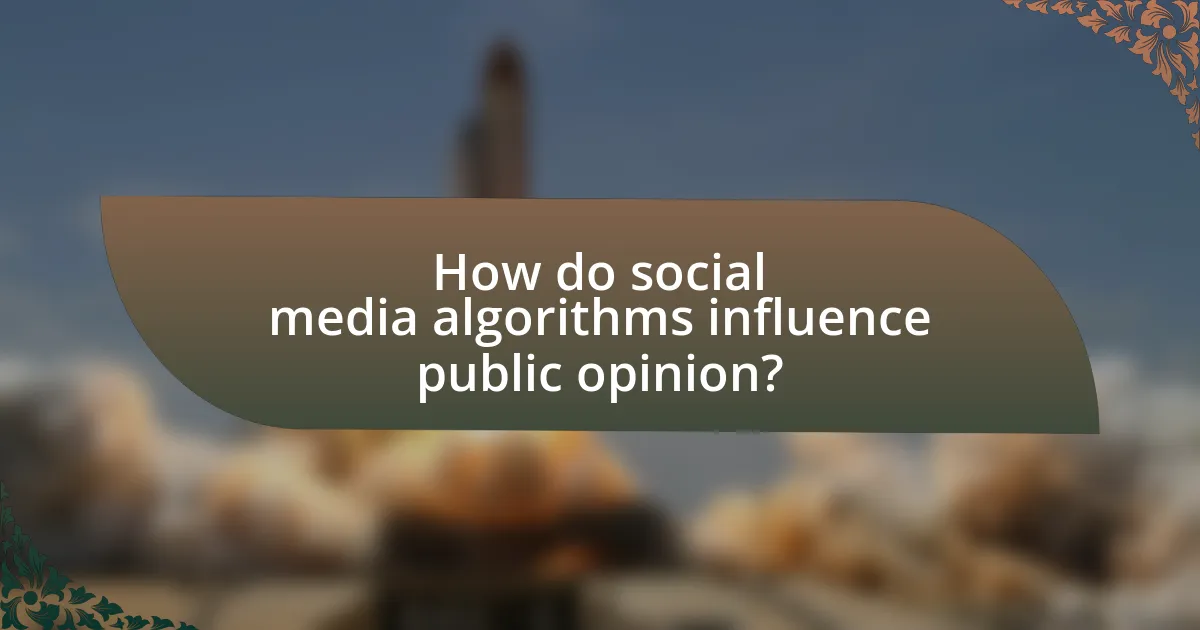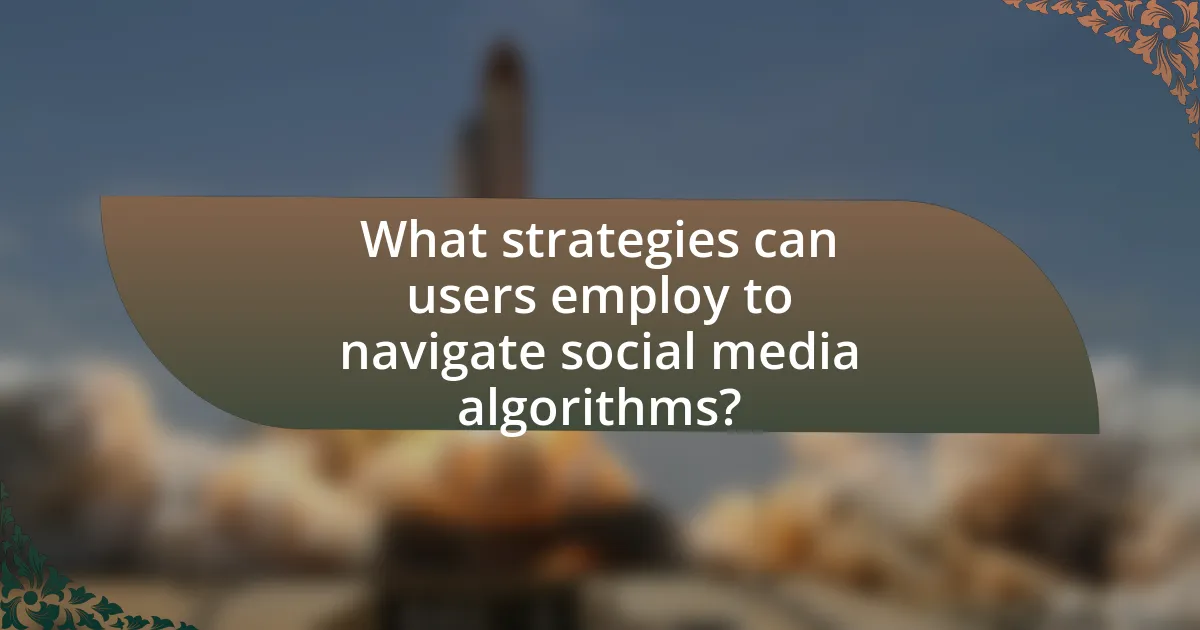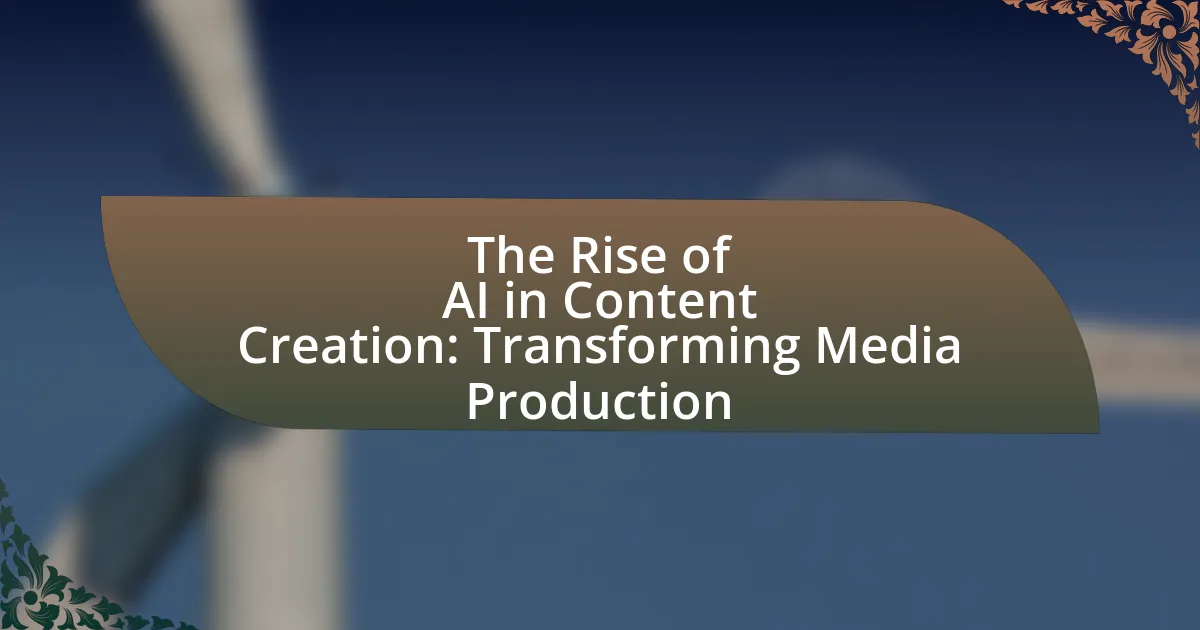Social media algorithms play a crucial role in shaping public opinion by determining the visibility and reach of content based on user engagement and preferences. These algorithms prioritize posts that generate likes, shares, and comments, leading to selective exposure and the creation of echo chambers that reinforce existing beliefs. The article explores the functioning of social media algorithms, their impact on misinformation, political polarization, and the ethical considerations involved in their design. It also discusses strategies for users to navigate these algorithms, assess content critically, and diversify their information sources to mitigate algorithmic bias.

How do social media algorithms influence public opinion?
Social media algorithms influence public opinion by determining the visibility and reach of content based on user engagement and preferences. These algorithms prioritize posts that generate likes, shares, and comments, effectively shaping the information users are exposed to. For instance, a study by the Pew Research Center found that 64% of Americans believe social media has a significant impact on their views about political issues. This selective exposure can create echo chambers, where users are predominantly exposed to viewpoints that reinforce their existing beliefs, thereby skewing public perception and discourse.
What are social media algorithms and how do they function?
Social media algorithms are complex mathematical formulas used by platforms to determine which content is shown to users based on their preferences and behaviors. These algorithms analyze user interactions, such as likes, shares, comments, and time spent on posts, to curate a personalized feed that maximizes engagement. For instance, Facebook’s algorithm prioritizes posts from friends and family, while Instagram’s algorithm focuses on recent interactions to keep users engaged. This functionality is supported by data analytics, which allows platforms to refine their algorithms continuously, ensuring that the content remains relevant to individual users.
What key components make up social media algorithms?
Social media algorithms are primarily composed of user engagement metrics, content relevance signals, and personalization factors. User engagement metrics include likes, shares, comments, and time spent on posts, which indicate how users interact with content. Content relevance signals assess the quality and context of posts, often utilizing keywords, hashtags, and trending topics to determine what is most pertinent to users. Personalization factors tailor content to individual preferences based on past behavior, demographics, and interests, ensuring that users receive a customized feed. These components work together to influence what content is displayed, ultimately shaping public opinion by prioritizing certain narratives and viewpoints over others.
How do algorithms prioritize content for users?
Algorithms prioritize content for users by analyzing engagement metrics, user preferences, and contextual relevance. These algorithms assess factors such as likes, shares, comments, and viewing time to determine what content resonates most with individual users. For instance, Facebook’s algorithm uses a ranking system that weighs user interactions and relationships to surface posts that are likely to generate engagement, thereby influencing what users see in their feeds. Research indicates that content with higher engagement rates is more likely to be prioritized, as evidenced by studies showing that posts with more likes and comments receive increased visibility.
Why is understanding social media algorithms important for public opinion?
Understanding social media algorithms is crucial for public opinion because these algorithms determine the visibility and reach of content, influencing what information users encounter. For instance, algorithms prioritize posts based on user engagement, which can amplify certain viewpoints while suppressing others, thereby shaping public discourse. Research by the Pew Research Center indicates that 64% of Americans believe social media has a significant impact on their views about political issues, highlighting the algorithms’ role in shaping perceptions and opinions.
How do algorithms shape the information users are exposed to?
Algorithms shape the information users are exposed to by determining which content is prioritized in their feeds based on user behavior and preferences. These algorithms analyze data such as likes, shares, and comments to predict what users will engage with, thereby filtering and curating content that aligns with their interests. For instance, a study by the Pew Research Center found that 64% of Americans believe social media platforms have a significant impact on the news they see, illustrating how algorithmic curation influences public perception and opinion.
What role do algorithms play in the spread of misinformation?
Algorithms significantly contribute to the spread of misinformation by prioritizing engagement over accuracy. Social media platforms utilize algorithms that amplify content based on user interactions, such as likes, shares, and comments, rather than verifying the truthfulness of the information. This mechanism can lead to the rapid dissemination of false narratives, as sensational or misleading content often garners more engagement than factual reporting. Research from the Massachusetts Institute of Technology found that false news stories are 70% more likely to be retweeted than true stories, highlighting the effectiveness of algorithms in promoting misinformation.
What are the potential consequences of algorithm-driven public opinion?
Algorithm-driven public opinion can lead to polarization and misinformation. Algorithms prioritize content that generates engagement, often amplifying extreme viewpoints and creating echo chambers. Research indicates that exposure to algorithmically curated content can reinforce existing beliefs, reducing the diversity of perspectives individuals encounter. A study by the Pew Research Center found that 64% of Americans believe social media has a mostly negative effect on the way things are going in the country, highlighting concerns about the impact of algorithm-driven content on societal discourse. Additionally, algorithmic biases can perpetuate stereotypes and misinformation, as seen in instances where false narratives gain traction due to algorithmic amplification.
How can algorithms create echo chambers or filter bubbles?
Algorithms create echo chambers or filter bubbles by personalizing content based on user behavior, preferences, and interactions. This personalization leads to the amplification of similar viewpoints while filtering out diverse perspectives, resulting in a limited information environment. For instance, a study by the Pew Research Center found that social media users are more likely to encounter information that aligns with their existing beliefs, reinforcing their views and isolating them from opposing opinions. Consequently, algorithms prioritize engagement metrics, such as likes and shares, which often favor sensational or emotionally charged content, further entrenching users in their established beliefs.
What impact do algorithms have on political polarization?
Algorithms significantly contribute to political polarization by curating content that reinforces users’ existing beliefs. Social media platforms utilize algorithms to analyze user behavior and preferences, leading to the promotion of similar viewpoints while filtering out opposing perspectives. This selective exposure creates echo chambers, where individuals are less likely to encounter diverse opinions, thereby intensifying ideological divides. Research from the Pew Research Center indicates that 62% of Americans believe social media platforms have a negative impact on the way political issues are discussed, highlighting the role of algorithms in shaping public discourse and increasing polarization.

How do social media platforms implement their algorithms?
Social media platforms implement their algorithms by utilizing complex mathematical models and machine learning techniques to analyze user data and behavior. These algorithms prioritize content based on factors such as user engagement, relevance, and recency, which are derived from vast amounts of data collected from user interactions. For instance, Facebook’s algorithm uses a ranking system that considers likes, shares, and comments to determine which posts appear in a user’s news feed, thereby influencing what content is seen and shared. This method is supported by research indicating that algorithms can significantly shape user perceptions and opinions by controlling the information flow, as highlighted in studies like “The Filter Bubble” by Eli Pariser, which discusses how personalized content can create echo chambers.
What factors do platforms consider when designing their algorithms?
Platforms consider user engagement, content relevance, and data privacy when designing their algorithms. User engagement metrics, such as likes, shares, and comments, help platforms determine which content resonates most with audiences, thereby influencing visibility. Content relevance is assessed through user behavior and preferences, ensuring that users receive personalized feeds that align with their interests. Data privacy regulations, such as the General Data Protection Regulation (GDPR), also play a crucial role, as platforms must balance algorithmic effectiveness with compliance to protect user information. These factors collectively shape how content is prioritized and presented, ultimately influencing public opinion.
How do user engagement metrics influence algorithm development?
User engagement metrics significantly influence algorithm development by guiding the optimization of content delivery to maximize user interaction. Algorithms analyze data such as likes, shares, comments, and time spent on posts to determine which content resonates most with users. For instance, platforms like Facebook and Instagram utilize these metrics to prioritize posts that generate higher engagement, thereby shaping the content users see in their feeds. This approach is supported by research indicating that increased engagement correlates with user retention and satisfaction, leading to a more personalized experience that can ultimately affect public opinion.
What ethical considerations are involved in algorithm design?
Ethical considerations in algorithm design include fairness, transparency, accountability, and privacy. Fairness ensures that algorithms do not perpetuate bias or discrimination against certain groups, as evidenced by studies showing that biased training data can lead to discriminatory outcomes in areas like hiring and law enforcement. Transparency involves making the workings of algorithms understandable to users, which is crucial for trust and informed consent. Accountability refers to the responsibility of designers and organizations to address the impacts of their algorithms, particularly when they influence public opinion and behavior. Privacy concerns arise from the collection and use of personal data, necessitating adherence to regulations like GDPR to protect user information. These considerations are essential in shaping algorithms that responsibly influence public discourse and societal norms.
How do different social media platforms vary in their algorithmic approaches?
Different social media platforms employ distinct algorithmic approaches to curate content for users. For instance, Facebook utilizes a machine learning algorithm that prioritizes engagement metrics, such as likes and shares, to determine what appears in a user’s news feed, often favoring posts from friends and family over brands. In contrast, Twitter’s algorithm focuses on recency and relevance, displaying tweets based on a combination of user interactions and trending topics, which can lead to a more real-time flow of information. Instagram, on the other hand, employs a visual-centric algorithm that emphasizes user preferences and interactions with specific types of content, such as images and videos, to personalize the feed. These variations in algorithmic strategies significantly influence how information is disseminated and perceived, shaping public opinion by determining which content is most visible to users.
What are the unique features of algorithms on platforms like Facebook, Twitter, and Instagram?
Algorithms on Facebook, Twitter, and Instagram uniquely prioritize content based on user engagement, relevance, and personalization. Facebook’s algorithm emphasizes interactions with friends and family, showcasing posts that generate meaningful engagement, while also incorporating factors like time spent on content and user preferences. Twitter’s algorithm focuses on recency and engagement, promoting tweets that are likely to spark conversations and interactions, thus enhancing real-time discussions. Instagram’s algorithm prioritizes visual content that users engage with most, using metrics such as likes, comments, and shares to determine visibility in users’ feeds. These distinct features collectively shape how information is disseminated and consumed, influencing public opinion by amplifying certain narratives and content types based on user behavior and preferences.
How do these differences affect user experience and public opinion?
Differences in social media algorithms significantly affect user experience and public opinion by determining the content visibility and engagement levels. For instance, algorithms that prioritize sensational or polarizing content can lead to increased user engagement but may also create echo chambers, where users are exposed primarily to viewpoints that reinforce their own beliefs. This phenomenon can skew public opinion by amplifying extreme perspectives while marginalizing moderate voices. Research by the Pew Research Center indicates that 64% of Americans believe social media has a mostly negative effect on the way things are going in the country, highlighting the public’s concern over how algorithmic biases shape discourse.
What challenges do platforms face in refining their algorithms?
Platforms face significant challenges in refining their algorithms, primarily due to issues related to data bias, user privacy, and the complexity of human behavior. Data bias can lead to skewed algorithmic outcomes, as algorithms trained on biased datasets may reinforce existing stereotypes or misinformation. For instance, a study by ProPublica in 2016 highlighted how algorithms used in criminal justice were biased against minority groups, demonstrating the real-world implications of biased data.
User privacy concerns complicate algorithm refinement, as platforms must balance the need for data to improve algorithms with the legal and ethical obligations to protect user information. The General Data Protection Regulation (GDPR) in Europe imposes strict guidelines on data usage, limiting the types of data that can be collected and analyzed.
Additionally, the complexity of human behavior poses a challenge, as algorithms must adapt to rapidly changing social dynamics and user preferences. Research from MIT in 2018 showed that social media interactions are influenced by a variety of factors, making it difficult for algorithms to accurately predict user engagement. These challenges collectively hinder platforms’ efforts to create fair, effective, and responsive algorithms.
How do user feedback and data privacy concerns shape algorithm changes?
User feedback and data privacy concerns significantly influence algorithm changes by prompting platforms to adjust their algorithms to enhance user satisfaction and comply with regulations. For instance, when users express dissatisfaction with content recommendations, platforms like Facebook and YouTube analyze this feedback to refine their algorithms, aiming to improve user engagement and retention. Additionally, data privacy regulations such as the General Data Protection Regulation (GDPR) compel companies to modify their algorithms to ensure compliance, which often includes limiting data collection and enhancing user control over personal information. This dual influence of user feedback and privacy concerns leads to more transparent and user-centric algorithmic practices, as evidenced by the increased emphasis on ethical AI development in recent years.
What are the implications of algorithm transparency for public trust?
Algorithm transparency significantly enhances public trust by allowing users to understand how decisions are made by algorithms. When individuals can see the criteria and processes behind algorithmic outputs, they are more likely to feel confident that these systems operate fairly and without bias. Research indicates that transparency can reduce skepticism and increase acceptance of algorithmic decisions, as evidenced by a study published in the Journal of Communication, which found that users who understood algorithmic processes were more likely to trust the platforms using them. Thus, algorithm transparency serves as a crucial factor in fostering trust between social media platforms and their users.

What strategies can users employ to navigate social media algorithms?
Users can navigate social media algorithms by curating their content consumption, engaging actively with preferred posts, and utilizing platform features like lists or favorites. Curating content involves following accounts that align with personal interests, which helps the algorithm prioritize relevant posts. Active engagement, such as liking, sharing, or commenting on posts, signals to the algorithm the types of content users prefer, thereby increasing the visibility of similar posts. Additionally, using features like lists on Twitter or favorites on Instagram allows users to organize their feeds, ensuring they see content from specific accounts more frequently. These strategies are effective because algorithms are designed to enhance user experience by promoting content that aligns with individual preferences, as evidenced by studies showing that engagement metrics directly influence content visibility.
How can users critically assess the content presented by algorithms?
Users can critically assess the content presented by algorithms by employing a systematic approach that includes evaluating the source, cross-referencing information, and understanding algorithmic biases. Evaluating the source involves checking the credibility and expertise of the content provider, which can reveal potential biases or agendas. Cross-referencing information with multiple reputable sources helps to verify the accuracy and reliability of the content, reducing the risk of misinformation. Understanding algorithmic biases is crucial, as algorithms often prioritize content based on user engagement metrics, which can skew the representation of diverse viewpoints. Research indicates that algorithm-driven content can create echo chambers, reinforcing existing beliefs rather than presenting a balanced perspective. By actively engaging in these practices, users can better navigate the complexities of algorithmically curated content.
What tools or techniques can help users identify biased information?
Users can identify biased information using fact-checking websites, media literacy education, and bias detection tools. Fact-checking websites like Snopes and FactCheck.org provide verified information and debunk false claims, helping users discern factual accuracy. Media literacy education equips individuals with critical thinking skills to analyze sources and recognize bias in reporting. Additionally, bias detection tools such as Media Bias/Fact Check and Ad Fontes Media categorize news outlets based on their political leanings, enabling users to assess the potential bias of the information they consume. These resources collectively empower users to navigate information critically and make informed judgments about content.
How can users diversify their information sources to counteract algorithmic bias?
Users can diversify their information sources to counteract algorithmic bias by actively seeking content from a variety of platforms, including independent news outlets, academic journals, and international media. This approach reduces reliance on algorithms that may prioritize certain viewpoints over others, thereby providing a more balanced perspective. Research indicates that exposure to diverse viewpoints can enhance critical thinking and reduce polarization (Pew Research Center, 2020). By following different social media accounts, subscribing to newsletters, and engaging with content that challenges their existing beliefs, users can create a more comprehensive understanding of issues, ultimately mitigating the effects of algorithmic bias.
What best practices can users adopt to enhance their social media experience?
Users can enhance their social media experience by curating their feeds, engaging thoughtfully, and maintaining privacy. Curating feeds involves following accounts that align with personal interests and values, which can lead to a more enjoyable and relevant content experience. Engaging thoughtfully means participating in discussions, sharing insights, and providing constructive feedback, which fosters a positive community atmosphere. Maintaining privacy is crucial; users should regularly review privacy settings to control who sees their content and personal information, thereby protecting themselves from unwanted exposure. According to a study by Pew Research Center, 70% of social media users have adjusted their privacy settings, indicating awareness of the importance of privacy in enhancing their overall experience.
How can users adjust their settings to influence algorithmic outcomes?
Users can adjust their settings to influence algorithmic outcomes by modifying preferences related to content visibility, engagement, and notification settings. For instance, users can select which types of posts they want to see more frequently, such as prioritizing friends’ updates over advertisements, thereby shaping the algorithm’s content delivery. Additionally, users can engage with specific content types—liking, sharing, or commenting—which signals to the algorithm their interests and preferences, leading to a more tailored feed. Research indicates that user interactions directly impact algorithmic recommendations, as platforms like Facebook and Instagram utilize engagement metrics to refine content delivery, thus demonstrating that active user participation can significantly alter algorithmic outcomes.
What role does active engagement play in shaping algorithmic recommendations?
Active engagement significantly influences algorithmic recommendations by providing data that helps algorithms understand user preferences and behaviors. When users interact with content—through likes, shares, comments, or time spent viewing—these actions signal to algorithms what types of content are relevant and appealing. For instance, a study by Facebook revealed that user engagement metrics directly affect the visibility of posts in users’ feeds, as higher engagement leads to increased prioritization of similar content. This feedback loop ensures that algorithms continuously adapt to user interests, ultimately shaping the content that users are exposed to and, consequently, influencing public opinion.
What resources are available for users to better understand social media algorithms?
Users can access various resources to better understand social media algorithms, including academic research papers, online courses, and industry reports. For instance, the Pew Research Center provides comprehensive studies on social media usage and algorithm impacts, while platforms like Coursera and edX offer courses specifically focused on data science and algorithm design. Additionally, books such as “Algorithms of Oppression” by Safiya Umoja Noble explore the societal implications of algorithms. These resources collectively enhance users’ comprehension of how algorithms influence content visibility and public opinion.
Where can users find educational materials on algorithm literacy?
Users can find educational materials on algorithm literacy through online platforms such as Coursera, edX, and Khan Academy, which offer courses specifically focused on algorithms and their societal impacts. These platforms provide structured learning experiences, often developed by universities and industry experts, ensuring the content is credible and relevant. For instance, the course “Algorithmic Thinking” on Coursera, created by Rice University, covers fundamental concepts of algorithms and their applications in real-world scenarios, reinforcing the importance of understanding algorithms in shaping public opinion on social media.
What organizations focus on promoting transparency in social media algorithms?
Organizations that focus on promoting transparency in social media algorithms include the Electronic Frontier Foundation (EFF), the Center for Democracy & Technology (CDT), and the Algorithmic Justice League. The EFF advocates for user rights and transparency in technology, emphasizing the need for clear algorithmic accountability. The CDT works to ensure that technology serves democratic values, pushing for policies that require social media platforms to disclose their algorithmic processes. The Algorithmic Justice League highlights the importance of fairness and accountability in AI systems, advocating for transparency in how algorithms operate and affect users. These organizations collectively contribute to the discourse on algorithmic transparency and its implications for public opinion.




